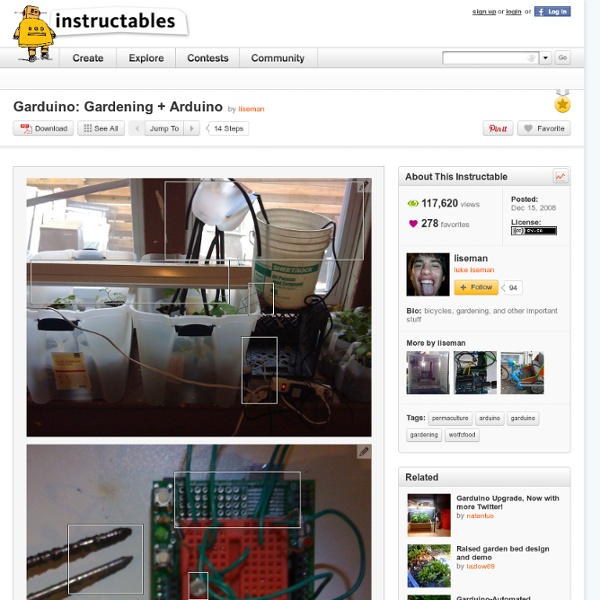



Garduino Upgrade, Now with more Twitter! A couple months ago I came across two great instructables. The first was the Garduino, an arduino controlled garden to help you grow plants at home. The second was the Tweet-a-Watt, a project that teaches you how to monitor your home power usage using Xbees and Twitter. I read about both these projects here at Instructables and in Make Magazine, Vol 18. I thought it would be great to combine both these projects and build myself an indoor garden that I could monitor from work via Twitter. If you're ready then head to the next step and begin the process!
Make Your Own Natural Bug Repellent Using Essential Oils « Hilltown Families Shoo Fly, Don’t Bother Me!By Tony(a) Lemos, HF Contributing Writer Click here to subscribe to the Hilltown Families weekly eNewsletter! Have it delivered to your email in box once a week for free! It is easy to make your own non-toxic bug spray by using store bought essential oils. Essential oils are steam-distilled pure concentrates of the natural oils present in plants, flowers, roots, and trees and can be purchased at your local health food store. The high amounts of essential oils that are so often found in store bought natural bug sprays are unnecessary, and can be made at home using less.To make your own insect repellent, combine rubbing alcohol, witch hazel, vodka, or olive oil with one of the essential oils listed below. Create your own natural bug repellent! If you find that you need to apply repellents several times throughout the day, and you are doing this everyday, I recommend that you make several different repellents and use them in alternation. Eat less sugar and more garlic!
Hydroponic Drip Garden for Vegetables, Herbs or Flowers Here are the items you will need:1 - 27 gallon heavy duty plastic storage box with recessed plastic lid10' of 1/2" PVC pipe5 - 90 deg PVC elbows3 - PVC T connectors1 - 3/4" to 1/2" PVC reducer1 - 3/4" PCV pipe to 3/4" Male Thread connector4 - 1/2" PVC J-Hook Hangers1 - Male Quick Disconnect to male 3/4" hose thread1 - Female Quick Disconnect to female 3/4" hose thread1 - 1/2" hose barb to female 3/4" hose thread 1 - rubber washer with filter screen3' of 1/2" flexible rubber hose1 - Active Aqua PU160 water pump12' 1/4' O.D. drip line hose12 - Drip stakes or drip nozzles with tie down stakes12 - Square Plastic pots sized to fit 3 across top of tote lid1 - 24 Hr timer with 15 minute on/off timing intervals The first 11 items on the list were all purchased from Home Depot and can be picked up at most hardware stores. The remaining item were purchased from a local hydroponics store in Billerica MA [www.greenlifegardensupply.com].
Home Built Hydroponics Unit for an 8th Grade Science Classroom - The Hydroshack Lives Again! My wife teaches 8th grade science. This project "The Hydroshack" is a rendition of one I built over 20 years ago in my college teaching methods class. It is designed specifically for performing experiments in a science class. Please keep in mind that this instructable is not the only way to do this. Features:Uses NFT (Nutrient Film Technique) - Nutrient solution flows along the bottom of the troughs and washes over the plants roots.Very dense plant arrangement to accommodate 150 students in a 5' x 2' footprintCounter top unit that breaks down to be stored above the cupboards in the classroomEasy access to replenish and clean the nutrient tanks.Flexible controls to allow for differing conditions: nutrient flow, nutrient solutions, lighting etc... in each trough. Educational conditions:The Hydroshack will be used to teach the students the "Scientific Method" (formal experimental procedures) and also be used in the genetics portion of the class. Also, I had to redesign the control panel.
My Indoor DWC Hydroponics System To the naked or untrained eye, plants can appear as very simple and boring forms of life. In reality, plants are very complex creatures. In fact, genetically speaking plants are about twice as complex as humans. They exist in two very separate yet two very interconnected and equally important worlds. The shoot system of the plant is what we normally see when we look at a plant in the ground. This chemical process is known as photosynthesis in which the radiant energy from the sun is harnessed and converted into chemical energy in the form of sugars. The process of photosynthesis is actually much more complex than the above chemical reaction. The root system is responsible for providing the leaves and the rest of the plant with the required raw materials for metabolism and photosynthesis. There are three main problems with soil that limit the growth of a plant:One is that soil does not contain a whole lot of oxygen that the roots need to survive.